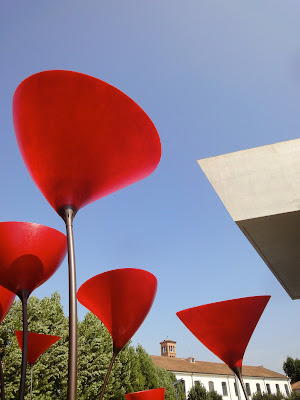Sunday, August 7, 2011
YAP @ MAXXI
I can't see YAP at PS1 this year (probably didn't miss much...), but I made it to Rome for the first ever YAP MAXXI.
MoMA PS1 joined force with MAXXI to launch the Italian edition of the established Young Architects Program. For over ten years in New York, YAP have brought in emerging young talents such as SHoP, WORKac, MOS, and SO-IL to transform the courtyards of PS1 into temporary summer events spaces with shade and water. This year for the MAXXI plaza, young Roman office stARTT was chosen as winner of the first YAP in Europe. The scheme WHATAMI injects a series of artificial green islands across the outdoor space. The main island, closer to the northeast corner of the site, features several zones of different qualities for people to hang out and relax. A "river" runs in front and forms a nice recreational "water edge." Large red calla lilies grow out of the grass and provide shading in the day and lighting at night. I feel that this is more about offering a nice and attractive place to the visitors than an "architectural" geometry play in the other YAP at PS1.
It's interesting to see the notion of architecture and gender here. Zaha's concrete building is curvy, but extremely severe and imposing at the same time. Right next to it, the male team of stARTT introduces more natural elements and to some extent they soften the aggressiveness of the strong lady with cheerful summer minds. The museum building and the new intervention co-exist in harmony, and they seem to be even complementary in a funny way.
I was surprised how well this was built. I know the PS1 budget was always so tight ($60,000-85,000, varying from year to year) that the architects usually chose very cheap materials and relied on volunteers for construction. I guess the recycled or natural materials that stARTT used, such as polystyrene and pressed hay, could still be considered "cheap." But in the making-of video shown in the gallery, I saw professional construction workers and serious metal cutting and welding work. Also, the red "flowers" were so well made that they easily top all the PS1 constructions I've seen. Maybe the city was convinced to increase funding because these high-tech objects were supposed to be relocated throughout Rome, in one of those abandoned places waiting for rehabilitation.




















No comments:
Post a Comment